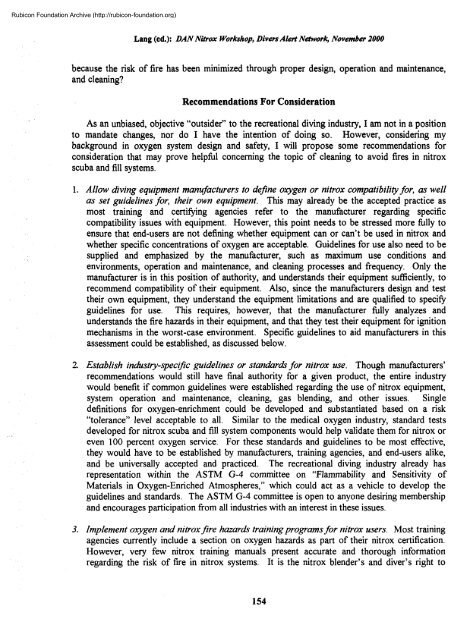Nitrox workshop dings - Divers Alert Network
Nitrox workshop dings - Divers Alert Network
Nitrox workshop dings - Divers Alert Network
Create successful ePaper yourself
Turn your PDF publications into a flip-book with our unique Google optimized e-Paper software.
Rubicon Foundation Archive (http://rubicon-foundation.org)Lang (ed.): DAN <strong>Nitrox</strong> Workshop, <strong>Divers</strong> <strong>Alert</strong> <strong>Network</strong>, November 2000because the risk of fire has been minimized through proper design, operation and maintenance,and cleaning?Recommendations For ConsiderationAs an unbiased, objective "outsider" to the recreational diving industry, I am not in a positionto mandate changes, nor do I have the intention of doing so. However, considering mybackground in oxygen system design and safety, I will propose some recommendations forconsideration that may prove helpful concerning the topic of cleaning to avoid fires in nitroxscuba and fill systems.1. Allow diving equipment manufacturers to define oxygen or nitrox compatibility for, as wellas set guidelines for, their own equipment. This may already be the accepted practice asmost training and certifying agencies refer to the manufacturer regarding specificcompatibility issues with equipment. However, this point needs to be stressed more fully toensure that end-users are not defining whether equipment can or can't be used in nitrox andwhether specific concentrations of oxygen are acceptable. Guidelines for use also need to besupplied and emphasized by the manufacturer, such as maximum use conditions andenvironments, operation and maintenance, and cleaning processes and frequency. Only themanufacturer is in this position of authority, and understands their equipment sufficiently, torecommend compatibility of their equipment. Also, since the manufacturers design and testtheir own equipment, they understand the equipment limitations and are qualified to specifyguidelines for use. This requires, however, that the manufacturer fully analyzes andunderstands the fire hazards in their equipment, and that they test their equipment for ignitionmechanisms in the worst-case environment. Specific guidelines to aid manufacturers in thisassessment could be established, as discussed below.2. Establish industry-specific guidelines or standards for nitrox use. Though manufacturers'recommendations would still have final authority for a given product, the entire industrywould benefit if common guidelines were established regarding the use of nitrox equipment,system operation and maintenance, cleaning, gas blending, and other issues. Singledefinitions for oxygen-enrichment could be developed and substantiated based on a risk"tolerance" level acceptable to all. Similar to the medical oxygen industry, standard testsdeveloped for nitrox scuba and fill system components would help validate them for nitrox oreven 100 percent oxygen service. For these standards and guidelines to be most effective,they would have to be established by manufacturers, training agencies, and end-users alike,and be universally accepted and practiced. The recreational diving industry already hasrepresentation within the ASTM G-4 committee on "Flammability and Sensitivity ofMaterials in Oxygen-Enriched Atmospheres," which could act as a vehicle to develop theguidelines and standards. The ASTM G-4 committee is open to anyone desiring membershipand encourages participation from all industries with an interest in these issues.3. Implement oxygen and nitrox fire hazards training programs for nitrox users. Most trainingagencies currently include a section on oxygen hazards as part of their nitrox certification.However, very few nitrox training manuals present accurate and thorough informationregarding the risk of fire in nitrox systems. It is the nitrox blender's and diver's right to154
















